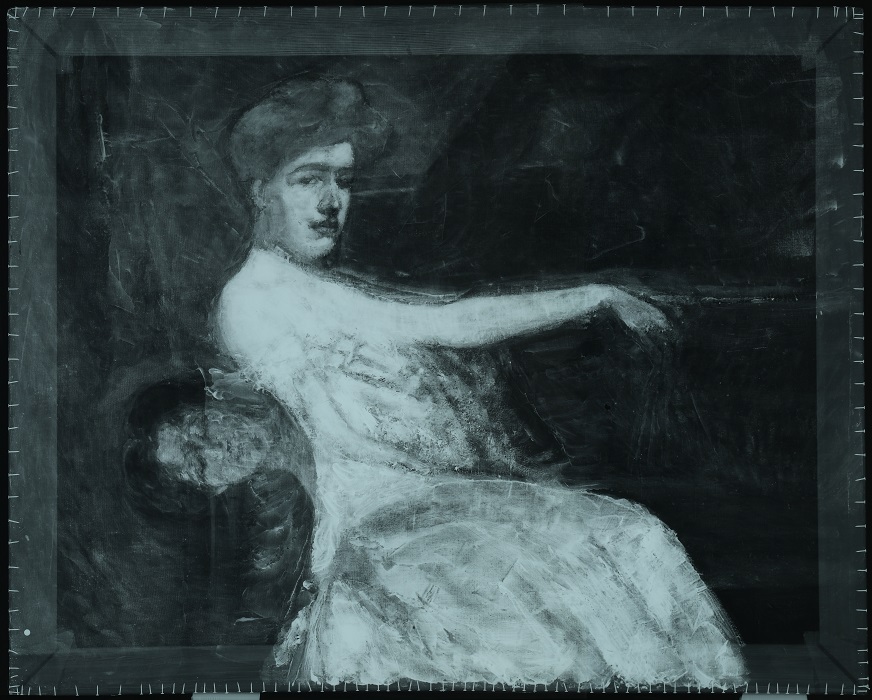The collections of the Staatliche Museen zu Berlin contain countless objects with surprising, hidden histories and provenances. The exhibition (Un)seen Stories. Looking, Locating, Illuminating focuses on these stories and the methods museologists use to research and tell them. In the cross-collection special exhibition “(Un)seen Stories. Looking, Locating, Illuminating”, that starts on 31 May 2024, 26 trainees from 20 collections and institutes of the Prussian Cultural Heritage Foundation present more than 70 unusual and rarely shown objects and stories.
Image above: Röntgenaufnahme des Gemäldes “Dame auf dem Sofa” von Fritz Rhein, ca. 1905, © Alte Nationalgalerie, Staatliche Museen zu Berlin / Andres Kilger.
Museums are not neutral places. They are subjective spaces that are critically scrutinised, especially in the contexts of nationalism and colonialism. New perspectives and points of view are included and emotions are increasingly permitted and discussed. They are also increasingly given space in exhibition architecture, lighting, routing and communication concepts. Museums are no longer merely representative places; they are polyphonic actors subject to social change.
For the exhibition, the young curators and academics have selected objects that have touched them personally and whose hidden, often exciting, unheard-of, or even tragic stories they are now making visible. Visitors are invited to discover the exhibition objects independently from new perspectives and to develop their own emotional connections, opinions, and attitudes. Feedback stations and digital exchange formats provide the opportunity to enter into dialogue with the exhibition makers.

Whether a 30 kg Reformation carpet, a forged van Gogh, or dismantled façade pieces of the Palace of the Republic: what at first glance appears to have nothing in common enables the discovery of emotional, surprising, and exciting narratives through new perspectives, technologies, provenance research, and cultural change. The exhibition offers four possible approaches to examine what is shown: visible clues on the object, material investigations and restorations, historical-cultural changes in values, and provenance research.
The visible is the starting point for any examination of an object: what information can be gleaned from its appearance? For example, an unopened box of papyri (Egyptian Museum and Papyrus Collection) from Elephantine Island from 1907 can provide a great deal of information: namely, about the location and archaeological practices of the time when
its contents could not yet be deciphered. Only now, over 100 years after i was filled, are the contents of this box being analysed. The box itself is now a historical artefact that can be used to trace the papyri’s long odyssey.
Material studies and restoration practices help to better understand the condition, structure, and production techniques of objects. The restoration of the painting Dame mit Kind (1910) by secession artist Fritz Rhein (Alte Nationalgalerie), for example, not only brought to light a completely unknown work behind the canvas: the Dame auf dem Sofa (ca. 1905), but X-ray examinations of the newly-discovered painting also revealed that a third, mysterious composition had been painted over.

Works of art, artefacts, and objects undergo complex changes in value throughout their history. Their role and cultural significance can often change completely. A Grafton saxophone from the 1950s (Musik- instrumenten-Museum) was initially derided as cheap and tasteless because of its acrylic construction. Only later did it become a coveted
collector’s item, used by jazz greats such as Charlie Parker and Ornette Coleman for recordings.
Investigating the origin of collection objects usually involves extensive provenance research. In the context of ethnological objects, narratives and testimonies from contact with the communities of origin are essential. For example, the curators retell the story of a Mapuche robe pin from the Ethnological Museum (which came to Berlin during the displacement of the Mapuche in Chile in the 19th century) from the perspective of these communities’ descendants and their relationship to the object.

Ute Franz-Scarciglia
WHEN?
Exhibition period:
Friday 31. May – Sunday 25. August 2024
Opening:
Thursday, 30 May 2024, 7 pm
WHERE?
Kupferstichkabinett in the Kulturforum
Matthäikirchplatz
10785 Berlin






